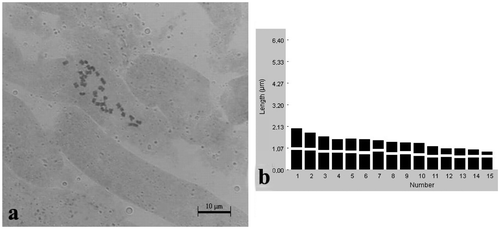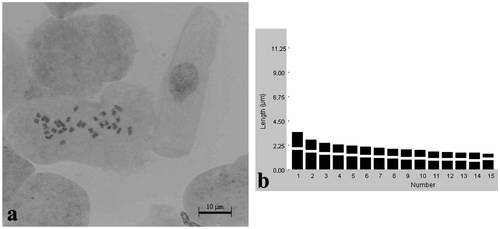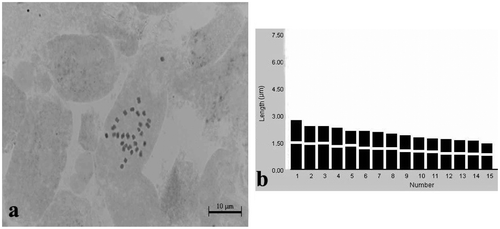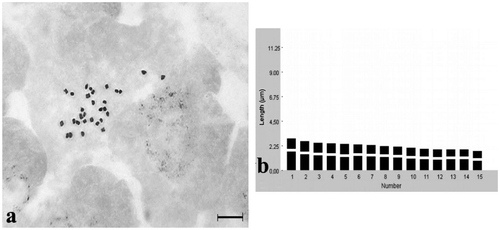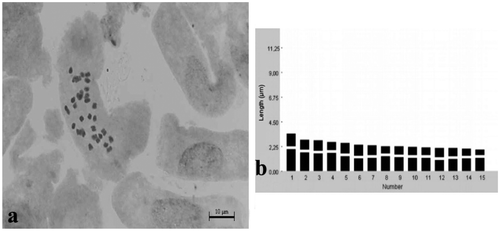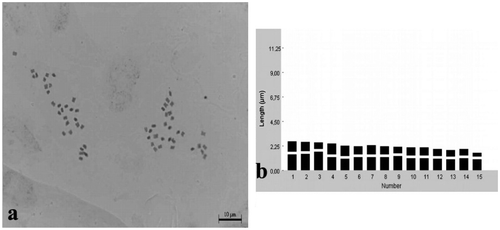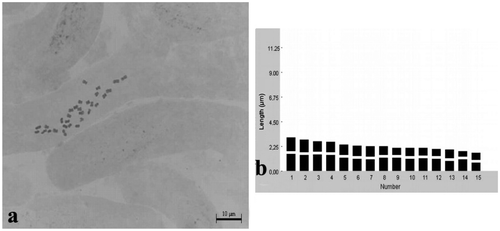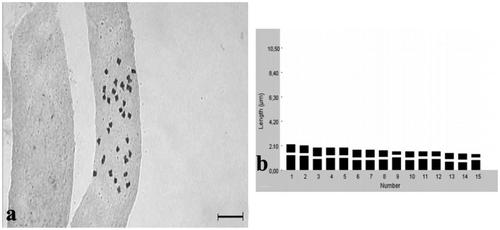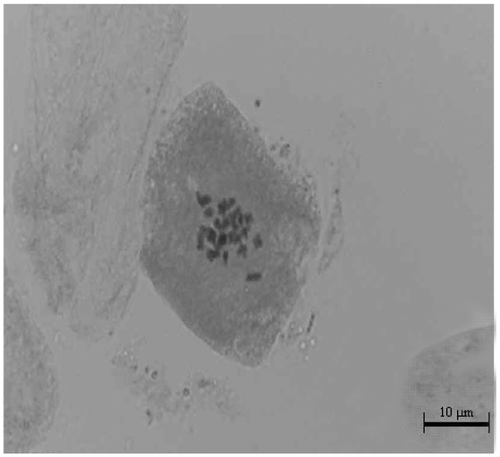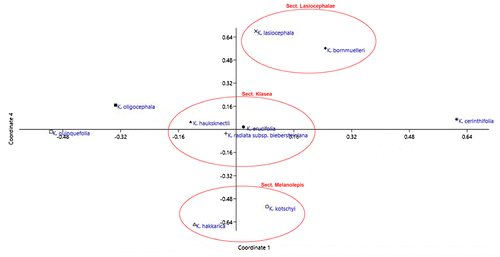Abstract
In the present study, karyotype analyses of 10 taxa belongs to the genus Klasea Cass. (Asteraceae) were conducted. Somatic chromosome numbers are not a distinctive character of classification of Klasea taxa. All of the taxa were counted as 2n = 30 chromosomes, except for Klasea radiata subsp. biebersteiniana (2n = 60). Although all the taxa have a chromosome number of 2n = 30, they could be differentiated by their karyotype formula and quantitative parameters of the karyotype. Karyotype analysis was performed by means of an Image Analysis System and karyotype asymmetry indices were measured. According to these parameters, karyological relationships among studied taxa were inferred.
Introduction
Asteraceae, with approximately 1620 genera and more than 23,600 species, is the largest family of flowering plants (Stevens Citation2001). This family is widely distributed across diverse regions ranging from southwest USA, Mexico, southern Brazil, South Africa, Middle and Southwest Asia as well as Australia. South America is accepted to be phylogenetically the geographic origin of the family (Bremer and Anderberg Citation1994). There are 1209 species of Asteraceae in the Flora of Turkey, of which 447 are endemic, with an endemism ratio of 37%. With a total number of 134 genera this family constitutes the second largest family of Turkish flora (Davis et al. Citation1988; Özhatay and Kültür Citation2006).
Klasea Cass. is an Old World genus of perennial herbs (Martins Citation2006; Ranjbar et al. Citation2012). This genus was treated as a section in Serratula L. for a long time, and finally was accepted at the generic level. Klasea is divided into 10 sections by Martins (Citation2006): Grandifoliae L. Martins, Melanolepis L. Martins, Lasiocephalae L. Martins, Leuzeopsis (Boriss.) L. Martins, Nikitinia (Iljin) L. Martins, Quinquefoliae L. Martins, Coriaceae L. Martins, Schumeria (Iljin) L. Martins, Klasea, and Demetria (Boriss.) L. Martins. In Turkey, the Eastern Mediterranean and Irano-Turanian phytogeographical region Klasea is represented by 15 species. Five of them are endemic and endemism rate is 31.25% (Doğan et al. Citation2012). In this study, chromosome numbers are reported for 11 Klasea taxa belonging to six sections. Karyomorphological observations were made on 10 of these taxa because the chromosomes of Klasea kurdica were not possible to measure.
Material and methods
According to the classification of Martins (Citation2006), we analyzed 10 Klasea taxa in six sections: Klasea, Quinquefoliae, Lasiocephalae, Melanolepis, Demetria, and Schumeria (for species see Table ). The plant samples were collected from different localities in Turkey (Table ). For karyotypes, root tips were obtained from germinating cypselae; this process took about 10 days on wet filter paper in Petri dishes. Root tips were pretreated with α-monobromonaphthalene for 16 h at 4°C, and then fixed in Carnoy’s solution absolute ethanol and glacial acetic acid (3:1) for 24 h and stored at 4°C until use. Root tips were washed in distilled water to remove the fixative, hydrolyzed in 1N HCl for 13 min at room temperature and stained in 2% aceto-orcein for 2 h. Permanent slides were made with the standard liquid nitrogen method; slides were dried for 24 h at room temperature and mounted in DEPEX. Karyotype analyses were made by using Bs200Pro Image Analysis Software (http://www.bab.com.tr/). Chromosomes were classified using the nomenclature of Levan et al. (Citation1964) as median (m), submedian (sm), subterminal (st) and terminal position (T). Idiograms for each taxon were built according to decreasing chromosome length.
Table 1. Localities and dates of collection for the Klasea material used in the present study.
Karyological characters and data analysis
According to Peruzzi and Eroğlu (Citation2013) and Peruzzi and Altınordu (Citation2014), we used chromosome number (2n), basic chromosome number (x), total haploid length of chromosome set (THL), together with CVCI (coefficient of variation of centromeric index) and CVCL (coefficient of variation of chromosome length) (Paszko Citation2006) and the karyotype asymmetry MCA (mean centromeric asymmetry) (Peruzzi and Eroğlu Citation2013). These data were subjected to Principal Coordinate Analysis (PCoA) analysis using Gower’s general coefficient of similarity. To determine karyological relationships among studied taxa of Klasea, we used the software Past 3.03 (Hammer et al. Citation2001; Hammer Citation2013).
Results
Section Melanolepis
Klasea kotschyi (Boiss.) Greuter & Wagenitz
The chromosome number of Klasea kotschyi is 2n = 30 (Figure a). The chromosome size ranges from 1.13 μm to 2.39 μm, and haploid chromosome length is 12.33 μm. The karyotype formula of this taxon consists of 10m+5sm pairs. The idiogram is given in Figure b.
Klasea hakkiarica (P. H. Davis) Greuter & Wagenitz
The chromosome number of Klasea hakkiarica is 2n = 30 (Figure a). The chromosome size ranges from 1.18 μm to 2.15 μm, and haploid chromosome length is 12.48 μm. The karyotype formula of this taxon consists of 13m+2sm pairs. The idiogram is given in Figure b.
Section Quinquefoliae
Klasea quinquefolia (Willd.) Greuter & Wagenitz
The chromosome number of Klasea quinquefolia is 2n = 30 (Figure a). The chromosome size ranges from 1.18 μm to 2.93 μm, and haploid chromosome length is 13.36 μm. The karyotype formula of this taxon consists of 9m+6sm pairs. The idiogram is given in Figure b.
Section Klasea
Klasea erucifolia (L.) Greuter & Wagenitz
The chromosome number of Klasea erucifolia is 2n = 30 (Figure a). The chromosome size ranges from 1.23 μm to 2.75 μm, and haploid chromosome length is 13.84 μm. The karyotype formula of this taxon consists of 8m+7sm pairs. The idiogram is given in Figure b.
Klasea haussknechtii (Boiss.) Holub
The chromosome number of Klasea haussknechtii is 2n = 30 (Figure a). The chromosome size ranges from 1.48 μm to 2.61 μm, and haploid chromosome length is 14.79 μm. The karyotype formula of this taxon consists of 14m+1sm pairs. The idiogram is given in Figure b.
Klasea radiata subsp. biebersteiniana (Grossh.) Greuter
The chromosome number of Klasea radiata subsp. biebersteiniana is 2n = 60 (Figure a). The chromosome size ranges from 1.12 μm to 2.52 μm, and haploid chromosome length is 13.11 μm. The karyotype formula of this taxon consists of 18m+12sm pairs. The idiogram is given in Figure b.
Figure 6. Klasea radiata subsp. biebersteiniana. (a) Metaphase chromosomes (scale bar 10 μm); (b) idiogram.

Section Lasiocephalae
Klasea lasiocephala (Bornm.) Greuter & Wagenitz
The chromosome number of Klasea lasiocephala is 2n = 30 (Figure a). The chromosome size ranges from 1.71 μm to 3.14 μm, and haploid chromosome length is 16.09 μm. The karyotype formula of this taxon consists of 7m+8sm pairs. The idiogram is given in Figure b.
Klasea bornmuelleri (Azn.) Greuter & Wagenitz
The chromosome number of Klasea bornmuelleri is new to science and 2n = 30 (Figure a). The chromosome size ranges from 1.26 μm to 2.01 μm, and haploid chromosome length is 12.21 μm. The karyotype formula of this taxon consists of 6m+9sm pairs. The idiogram is given in Figure b.
Section Demetria
Klasea oligocephala (DC.) Greuter & Wagenitz
The chromosome number of Klasea oligocephala is 2n = 30 (Figure a). The chromosome size ranges from 1.43 μm to 2.81 μm, and haploid chromosome length is 15.18 μm. The karyotype formula of this taxon consists of 12m+3sm pairs. The idiogram is given in Figure b.
Section Schumeria
Klasea cerinthifolia (Sm.) Greuter & Wagenitz
The chromosome number of Klasea cerinthifolia is 2n = 30 (Figure a). The chromosome size ranges from 1.10 μm to 1.97 μm, and haploid chromosome length is 11.10 μm. Chromosome arm ratios are measured as 1.23–3.78. The karyotype formula of this taxon consists of 9m+4sm+2st pairs. The idiogram is given in Figure b.
Klasea kurdica (Post) Greuter & Wagenitz
The chromosome number of Klasea kurdica is 2n = 30 (Figure ). Since the chromosomes were not possible to measure, the karyotype of this taxon could not be analyzed.
Consequently, chromosome morphology and karyotype asymmetry of Klasea kotschyi, K. quinquefolia, K. erucifolia, K. hakkiarica, K. lasiocephala, K. oligocephala, K. haussknechtii, K. cerinthifolia, K. bornmuelleri and K. radiata subsp. biebersteiniana were identified. Chromosome numbers and karyomorphological features are given (Table ). Also detailed karyotype asymmetry indices and variability of asymmetry indices among species are given (Table ). PCoA analysis was used to show karyological relationships among Klasea taxa and PCoA cumulative variance explained by the first two axes: 62.5%. In this case, the taxa belonging to the same section tend to cluster together (Figure ).
Table 2. Karyomorphological features of Klasea taxa.
Table 3. Karyological characters including karyotype symmetry indices for studied taxa.
Discussion
All taxa were counted as 2n = 30 except for Klasea radiata subsp. biebersteiniana. The karyomorphologic and asymmetry characters are useful to determine the karyological relationship of studied taxa.
The lowest CVCI value, indicating a chromosome complement with a more homogeneous centromere position, was observed in K. hauksnectii. The most heterogeneous centromere positions occur in K. bornmuelleri. CVCL values range between 13.29 and 26.73 and K. quinquefolia shows the highest interchromosomal asymmetry with a value of 26.73. K. bornmuelleri has the highest intrachromosomal asymmetry (MCA) value, 26.93, and K. oligocephala possess lowest MCA of 16.94.
Section Quinquefoliae is sister to sect. Demetria (Martins Citation2006). Klasea quinquefolia and K. oligocephala showed similar karyological features. Also within sect. Klasea, K. hauksnectii, K. radiata subsp. biebersteiniana and K. erucifolia clustered together and were karyologically similar to sect. Quinquefoliae and sect. Demetria. Klasea bornmuelleri and K. lasiocephala, in Lasiocephalae sect. (Martins Citation2006), were karyologically similar. In Melanolepis sect., Klasea hakkiarica and Klasea kotschyi were considered and our results were congruent with Martins (Citation2006).
According to Hidalgo et al. (Citation2007), the basic chromosome number of Klasea was reported as x = 15. Chromosome numbers of Klasea cerinthifolia (Sm.) Greuter & Wagenitz and K. grandifolia (P. H. Davis) Greuter & Wagenitz, were reported as 2n = 30 (Garcia-Jacas et al. Citation1998; Hidalgo et al. Citation2007).
Cueto Romero and Blanca Lopez (Citation1987) reported the chromosome number of Klasea nudicaulis (L.) Fourr. as 2n = 30. Cantó (Citation1982) reported a diploid chromosome number of 2n = 30 + (0–4B) for this taxon. Cantó (Citation1982) also studied Klasea taxa, and obtained the following chromosome numbers: Klasea baetica subsp. alcalae Cantó & R. Mart. as 2n = 30; K. baetica subsp. lusitanica (Cantó) Cantó & R. Mart. as 2n = 30, 60; K. legionensis (Lacaita) J. Holub as 2n = 30; K. integrifolia (Vahl) Greuter as 2n = 30, 90; K. flavescens subsp. leucantha (Cav.) Cantó & R. Mart. as 2n = 30; K. flavescens subsp. mucronata (Desf.) Cantó & R. Mart. as 2n = 60; K. pinnatifida (Cav.) Talavera as 2n = 60 and 90. Also Fernandez and Queiros (Citation1971) expressed the chromosome number for Klasea pinnatifida as 2n = 90.
Chromosome numbers of Klasea lycopifolia (Vill.) Á. Löve & D. Löve, K. radiata subsp. biebersteiniana and K. radiata (Waldst. & Kit.) Á. Löve & D. Löve were reported as 2n = 30 and 60 (Pogan et al. Citation1989). Conversely, 2n = 28 and 2n = 26 chromosome numbers were determined for K. serratuloides (DC.) Greuter & Wagenitz and K. coriacea Holub, respectively, by Tonian (Citation1980).
In Central and Northwest Europe, some taxa of Klasea were studied and the diploid chromosome number of 2n = 30 has been reported (Löve and Löve Citation1961).
But according to the literature, no karyotype information is available for this genus. In this study, we performed karyotype analyses of 10 Klasea taxa.
As well as having the same chromosome number, karyotype formulae were found to be different. The karyotypes are mostly formed of metacentric and submetacentric chromosome pairs. Only Klasea cerinthifolia has a subtelocentric chromosome type.
The chromosome numbers and karyotype details of Klasea taxa were identified and this has contributed to the systematic knowledge of the genus.
Acknowledgments
We express our thanks to TUBITAK [project no. TBAG-109-T-243] and the Scientific Investigation Projects Coordinate Office of Selçuk University [project no. 11401048] for financial support. I would like to thank Turan Arabacı, Meryem Öztürk and Özlem Çetin for their valuable contributions.
Disclosure statement
No potential conflict of interest was reported by the authors.
References
- Bremer K, Anderberg AA. 1994. Asteraceae: cladistics and classification. 1st ed. Portland (OR): Timbers Press.
- Cantó P. 1982. Números cromosómicos en algunos táxones del género Serratula L. (Asteraceae). Lazaroa. 3:190–194.
- Cueto Romero M, Blanca López G. 1987. Números cromosomáticos de plantas occidentales, 392–402. An Jard Bot Madrid. 43(2):403–409.
- Davis PH, Tan K, Mill RR. 1988. Flora of Turkey and the East Aegean Islands. Vol. 10. Edinburgh: Edinburgh University Press.
- Doğan B, Duran A, Martin E, Coşkun F. 2012. Türkiye Serratula L. cinsinin revizyonu. Project no: TÜBİTAK-TBAG-109T243 (in Turkish).
- Fernandez A, Queirós M. 1971. Contribution à la connaissance cytotaxinomique des Spermatophytadu Portugal. II. Compositae. Bol. Soc. Brot., Sér. 2. 45:5–121.
- Garcia-Jacas N, Susanna A, Vilatersana R, Guara M. 1998. New chromosome counts in the subtribe Centaureinae (Asteraceae, Cardueae) from West Asia. II. Bot J Linn Soc. 128(4):403–412.
- Hammer Ø. 2013. PAST 3.03. Available from http://folk.uio.no/ohammer/past.
- Hammer Ø, Harper DAT, Ryan PD. 2001. PAST: Paleontological Statistics sofware package for education and data analysis. Paleontologia Electronica. 4(1):1–9.
- Hidalgo O, Garcia-Jacas N, Garnatje T, Susanna A, Siljak-Yakovlev S. 2007. Karyological evolution in Rhaponticum Vaill. (Asteraceae, Cardueae) and related genera. Bot J Linn Soc. 153(2):193–201.
- Levan A, Fredga K, Sandberg AA. 1964. Nomenclature for centromeric position on chromosomes. Hereditas. 52(2):201–220.
- Löve Á, Löve D. 1961. Chromosome numbers of Central and Northwest European plant species. Opera Botanica. Vol. 5. Stockholm: Almqvist & Wiksell. p.1–581.
- Martins L. 2006. Systematics and biogeography of Klasea (Asteraceae–Cardueae) and a synopsis of the genus. Bot J Linn Soc. 152(4):435–464.
- Özhatay N, Kültür Ş. 2006. Check-list of additional taxa to the supplement Flora of Turkey III. Turk J Bot. 30(4):281–316.
- Paszko B. 2006. A critical review and a new proposal of karyotype asymmetry indices. Plant Syst Evol. 258(1):39–48.
- Peruzzi L, Altınordu F. 2014. A proposal for a multivariate quantitative approach to infer karyological relationships among taxa. Compar Cytogenet. 8(4):337–349.
- Peruzzi L, Eroğlu HE. 2013. Karyotype asymmetry: again, how to measure and what to measure? Compar Cytogenet. 7(1):1–9.
- Pogan E, Jankun A, Wcislo H. 1989. Further studies in chromosome numbers of Polish angiosperms. Part XXI. Acta Biol Cracov Bot. 30:119–136.
- Ranjbar M, Negaresh K, Karamian R, Joharchi MR. 2012. Klasea nana (Asteraceae), a new species from NE Iran. Ann Bot Fenn. 49(5):402–406.
- Stevens PF. 2001. Angiosperm phylogeny website version 8, June 2007 [and more or less continuously updated since]; [cited 2008 Mar 27]. http://www.mobot.org/MOBOT/research/APweb/
- Tonian TR. 1980. Relation between chromosome number and some morphological features of Centaureinae Less representatives. Biol Rev. 33(5):552–554.

